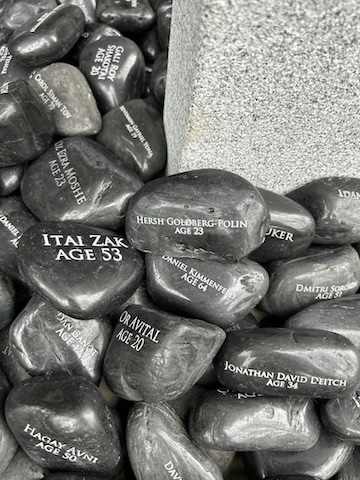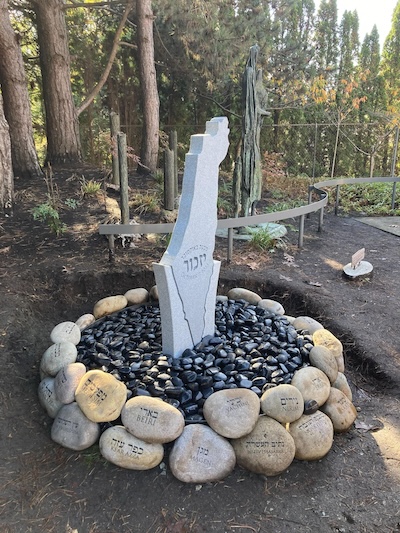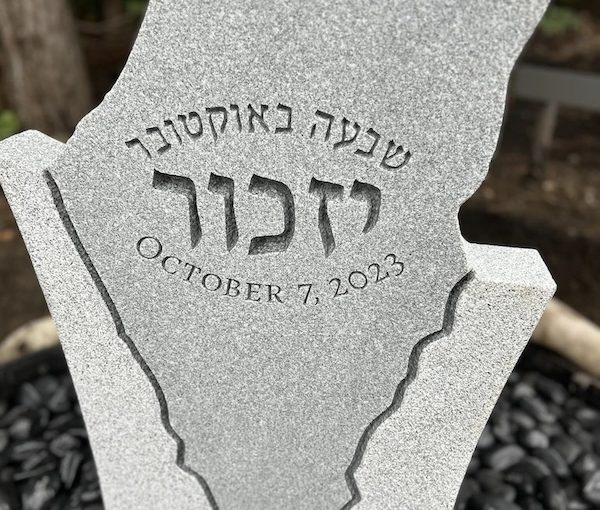A newly created monument in the garden of Temple Sholom Synagogue commemorates the victims of Oct. 7, 2023, and the Israeli civilians, soldiers and foreign nationals who have lost their lives since that day. (photo from Temple Sholom)
There’s a newly created monument in the garden of Temple Sholom Synagogue – a serene and contemplative space. It’s not a cemetery, as you might expect, but a place to remember the horrific events of Oct. 7, 2023, and the tremendous loss of Israeli civilians, soldiers and foreign nationals who have lost their lives since that day. The project, envisioned by Temple Sholom Senior Rabbi Dan Moskovitz, draws on the Jewish tradition of placing stones when visiting the graves of the deceased and the “stumbling stones” of Berlin. The monument stands adjacent to the Temple’s Holocaust memorial. The proximity of the two is its own heartbreaking reminder of Jewish loss and tragedy
The new monument is surrounded by 33 large boulders, each inscribed with the name of a town or kibbutz attacked on Oct. 7; there is also one for the Nova Music Festival. Encircling the monument’s base lie some 1,658 small black stones, each one bearing the name and age of a victim.
The act of placing stones on a grave signifies that the person’s soul is remembered and honoured. It reflects the belief that the soul continues to exist in the afterlife and that the memory of the deceased remains alive in the hearts of the living. In this case, Rabbi Moskovitz’s intention was to make sure his community remembers those killed not as one massive number but as individual Jews. Every individual had a unique life story, just as each stone is unique.
It was this topic that the rabbi talked about in his Kol Nidre sermon only days after the one-year anniversary of the Oct. 7 attacks. A reminder that we must keep the memory of every person who died on that horrible day alive. All members of the congregation were asked to take home a small black polished stone inscribed with the name and age of a victim of the Hamas attacks and the Israelis killed in the war since then.

Congregants were asked to research the name engraved on their stone(s); learn their story, their plans, and to even write a message on the stone if they so wished. They were then requested to bring their stone(s) back to the synagogue by Simchat Torah, when the monument would be dedicated. Moskovitz anticipated that the one-year anniversary that falls on the Jewish holiday, marred by the attacks, would be a time of sorrow, reflection and memory as the community gathered for what is otherwise a joyous holiday.
The sermon had a profound impact both in person and online. People wrote back from as far away as Thailand and the majority of synagogue members picked up a rock on their way home.
Inspiration for the monument came from when Moskovitz was a teenager. He recalls wearing a metal bracelet with the name of a Soviet refusenik, a Jew who was denied permission to emigrate to Israel. When the names of the hostages were gradually released, the rabbi said: “The idea struck me that we must hold on to the names of the hostages, share them and never let the world forget their torment and danger. I also wanted to do something to help raise money for the families and all of those in Israel forever changed and impacted by Oct 7. And so began the production and distribution of 10,000 bracelets engraved with the name of each hostage, their age and where they were taken from in a project called Till They All Come Home.”
As the anniversary approached, Moskovitz used the basis of the bracelet project to inspire the memorial stones. Temple Sholom Sisterhood provided the funding for the rabbi to purchase 1,000 pounds of stones and commission a five-foot-tall monument for the synagogue garden. Each stone was personally engraved by the rabbi and his family and the project took more than a month. Every victim was researched on the internet and often the entire family grieved as they reflected upon the age of the victim and the personal stories.
“Chana Kritzman’s was the first stone I picked up,” said Barb Halparin, a Temple Sholom congregant. “Its shape, a glistening black tear drop, attracted my attention. Chana’s age, 88, was etched below her name and I felt the immediate kinship of senior womanhood. Googling Chana’s name only intensified my sense of identification with her. I learned that, as a founding member of Kibbutz Be’eri, Chana had established the kibbutz library, where she ‘raised her children and grandchildren on a love of books, reading, and the art of storytelling.’
“I’ve been an avid reader all my life, and I earned my BA in English literature. I value my membership in the Isaac Waldman Library, and my favourite gift to my grandchildren is a book.”
Kritzman was shot by Hamas invaders while being evacuated from her home. She fought for her life in hospital for two weeks before succumbing to her wounds.
Halparin expressed how reading about Kritzman, her life, her love of words, her senseless, suffering death was a deeply emotional experience for her, as was placing her stone beside the memorial’s larger rock dedicated to Kibbutz Be’eri.
“It felt like I was in some small way bringing her home,” she said. “When Rabbi Moskovitz introduced the stumbling stone concept, I was deeply touched and eager to participate in such a meaningful project of remembrance.”
Another Temple Sholom member, Reisa Schneider, said: “One of the stones I took home was of Tair David, who was 23 years old when she and her sister Hodaya, age 26, were murdered by Hamas terrorists at the Nova music festival on Oct. 7, 2023. They were from the town of Beit Dagan. Their father, Uri, spent 30 minutes on the phone with them. He could hear blasts of gunfire nearby; he instructed them to lie on the ground, hold hands and breathe. Their connection was cut; he never heard from them again.”
On Instagram, their sister Liza wrote that Tair was “just like her name, a child of light, with a smile that could be seen for miles and a presence that is hard to hide.”
“I found it interesting, maybe even coincidental, that the name of the person who I was expected to remember meant light,” said Schneider. “We gave our middle daughter the Hebrew name Orah, which also means light. Additionally, my maiden name is Smiley. I have tried to keep the name alive by smiling authentically and frequently. I have happily and intentionally passed that quality on to my daughters and grandchildren. I plan to honour Tair’s memory by bringing light into this broken world and by continuing to smile, despite these challenging times.”

Synagogue member Louise Krivel wrote: “After hearing Rabbi Moskovitz’s amazing sermon on Yom Kippur and learning about the over 1,600 rocks that his family had engraved in memory of the victims of Oct. 7 and beyond, I felt a tremendous sense of responsibility to honour the memory of the individuals whose rocks our family had been given.
“I researched each one and reached out to a couple of Israeli families via Facebook to advise them of our synagogue’s memorial and to let them know what Rabbi Moskovitz had been responsible for creating.”
Yoni Znati, the father of Matan Znati, a 23-year-old Nova festival-goer, who died protecting his girlfriend, was one of those grieving family members Krivel contacted. He responded that he was very excited to hear about the memorial. He appreciated it very much, requested photos and hopes that, one day, he can meet Krivel so that he can tell her more about Matan.
“I can’t think of a more meaningful way that we as a congregation could honour the victims of Oct. 7,” Krivel shared. “I am so proud of Rabbi Moskovitz and his family and our congregation for creating this meaningful and beautiful memorial. Am Yisrael Chai.”
These are just three brief stories that Temple Sholom congregants researched from the horrific attack of Oct. 7 and those killed during the year since.
It’s after Simchat Torah. I am standing in the memorial garden. It’s now flooded with the rocks. Inside the synagogue, there’s a bat mitzvah. I can faintly hear the lively sounds of playfulness and laughter.
There will always be moments of celebration and sadness. As Kohelet (Ecclesiastes) reminds us, “To everything there is a season, and a time for every purpose under heaven.”
Jenny Wright is a writer, music therapist, children’s musician and recording artist.

